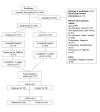Use of a Mobile Peer Support App Among Young People With Nonsuicidal Self-injury: Small-scale Randomized Controlled Trial
- PMID: 35006076
- PMCID: PMC8787664
- DOI: 10.2196/26526
Use of a Mobile Peer Support App Among Young People With Nonsuicidal Self-injury: Small-scale Randomized Controlled Trial
Abstract
Background: Nonsuicidal self-injury (NSSI) is a widespread behavior among adolescents and young adults. Although many individuals who self-injure do not seek treatment, there is evidence for web-based help-seeking through web-based communities and mobile peer support networks. However, few studies have rigorously tested the efficacy of such platforms on outcomes relevant for NSSI recovery.
Objective: The aim of this small-scale preregistered randomized controlled trial is to provide preliminary insight into the shorter- and longer-term efficacy of the use of a peer support app, TalkLife, in reducing NSSI frequency and urges and increasing readiness to change. In addition, we explore contact with informal support, interest in therapy, and attitudes toward professional help-seeking.
Methods: Individuals aged 16-25 years with current (within 3 months) and chronic (>6 episodes in the past year) NSSI history were eligible to participate in this study. After baseline assessments, the intervention group was instructed to use the app actively (eg, post or comment at least three times per week) and the control group received weekly psychoeducational materials through email, for 8 weeks. Follow-up was assessed at 1 month and 2 months. Linear mixed modeling was used to evaluate condition and time point effects for the primary outcomes of NSSI frequency and urges, readiness to change, contact with informal support, interest in therapy, and attitudes toward professional help-seeking.
Results: A total of 131 participants were included in the analysis. We evidenced a significant effect of condition on NSSI frequency such that the participants using the peer support app self-injured less over the course of the study (mean 1.30, SE 0.18) than those in the control condition (mean 1.62, SE 0.18; P=.02; η2=0.02). We also evidenced a significant condition effect of readiness to change such that the treatment participants reported greater confidence in their ability to change their NSSI behavior (mean 6.28, SE 0.41) than the control participants (mean 5.67, SE 0.41; P=.04; η2=0.02). No significant differences were observed for contact with informal support, interest in therapy, or attitudes toward professional help-seeking.
Conclusions: Use of the peer support app was related to reduced NSSI frequency and greater confidence in one's ability to change NSSI behavior over the course of the study period, but no effects on NSSI urges, contact with informal support, interest in therapy, or attitudes toward professional help-seeking were observed. The findings provide preliminary support for considering the use of mobile peer support apps as a supplement to NSSI intervention and point to the need for larger-scale trials.
Trial registration: Open Science Foundation; https://osf.io/3uay9.
Keywords: digital intervention; mobile app; nonsuicidal self-injury; peer support; randomized controlled trial; urges.
©Kaylee Payne Kruzan, Janis Whitlock, Natalya N Bazarova, Aparajita Bhandari, Julia Chapman. Originally published in JMIR Formative Research (https://formative.jmir.org), 10.01.2022.
Conflict of interest statement
Conflicts of Interest: None declared.
Similar articles
-
Young Adults' Perceptions of 2 Publicly Available Digital Resources for Self-injury: Qualitative Study of a Peer Support App and Web-Based Factsheets.JMIR Form Res. 2023 Jan 12;7:e41546. doi: 10.2196/41546. JMIR Form Res. 2023. PMID: 36633896 Free PMC article.
-
Zero Self-Harm app: a mobile phone application to reduce non-suicidal self-injury-study protocol for a randomized controlled trial.Trials. 2024 Feb 10;25(1):116. doi: 10.1186/s13063-024-07932-1. Trials. 2024. PMID: 38341590 Free PMC article.
-
How Technologies Can Support Self-Injury Self-Management: Perspectives of Young Adults With Lived Experience of Nonsuicidal Self-Injury.Front Digit Health. 2022 Jun 29;4:913599. doi: 10.3389/fdgth.2022.913599. eCollection 2022. Front Digit Health. 2022. PMID: 35847416 Free PMC article.
-
The Detection of Acute Risk of Self-injury Project: Protocol for an Ecological Momentary Assessment Study Among Individuals Seeking Treatment.JMIR Res Protoc. 2023 Jun 15;12:e46244. doi: 10.2196/46244. JMIR Res Protoc. 2023. PMID: 37318839 Free PMC article.
-
Effects of a Mobile and Web App (Thought Spot) on Mental Health Help-Seeking Among College and University Students: Randomized Controlled Trial.J Med Internet Res. 2020 Oct 30;22(10):e20790. doi: 10.2196/20790. J Med Internet Res. 2020. PMID: 33124984 Free PMC article. Clinical Trial.
Cited by
-
Mobile applications in adolescent psychotherapy during the COVID-19 pandemic: a systematic review.Front Public Health. 2024 Feb 14;12:1345808. doi: 10.3389/fpubh.2024.1345808. eCollection 2024. Front Public Health. 2024. PMID: 38420028 Free PMC article.
-
Young Adults' Perceptions of 2 Publicly Available Digital Resources for Self-injury: Qualitative Study of a Peer Support App and Web-Based Factsheets.JMIR Form Res. 2023 Jan 12;7:e41546. doi: 10.2196/41546. JMIR Form Res. 2023. PMID: 36633896 Free PMC article.
-
Views on the Functionality and Use of the PeerConnect App Among Public Safety Personnel: Qualitative Analysis.JMIR Form Res. 2023 Nov 6;7:e46968. doi: 10.2196/46968. JMIR Form Res. 2023. PMID: 37930765 Free PMC article.
-
The Journey From Nonimmersive to Immersive Multiuser Applications in Mental Health Care: Systematic Review.J Med Internet Res. 2024 Nov 7;26:e60441. doi: 10.2196/60441. J Med Internet Res. 2024. PMID: 39509153 Free PMC article.
-
Systematic review and meta-analysis of adverse events in clinical trials of mental health apps.NPJ Digit Med. 2024 Dec 18;7(1):363. doi: 10.1038/s41746-024-01388-y. NPJ Digit Med. 2024. PMID: 39695173 Free PMC article.
References
-
- What is nonsuicidal self-injury? International Society for the Study of Self-Injury. 2018. [2021-12-20]. https://itriples.org/about-self-injury/what-is-self-injury .
-
- Kiekens G, Hasking P, Boyes M, Claes L, Mortier P, Auerbach R, Cuijpers P, Demyttenaere K, Green J, Kessler R, Myin-Germeys I, Nock M, Bruffaerts R. The associations between non-suicidal self-injury and first onset suicidal thoughts and behaviors. J Affect Disord. 2018 Oct 15;239:171–9. doi: 10.1016/j.jad.2018.06.033.S0165-0327(17)32488-6 - DOI - PubMed
Grants and funding
LinkOut - more resources
Full Text Sources
Miscellaneous


